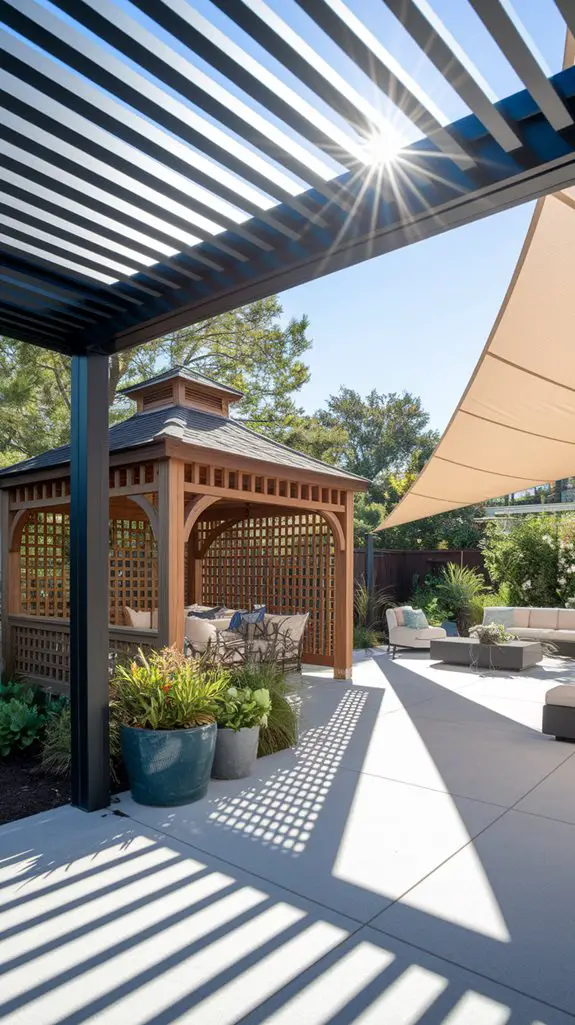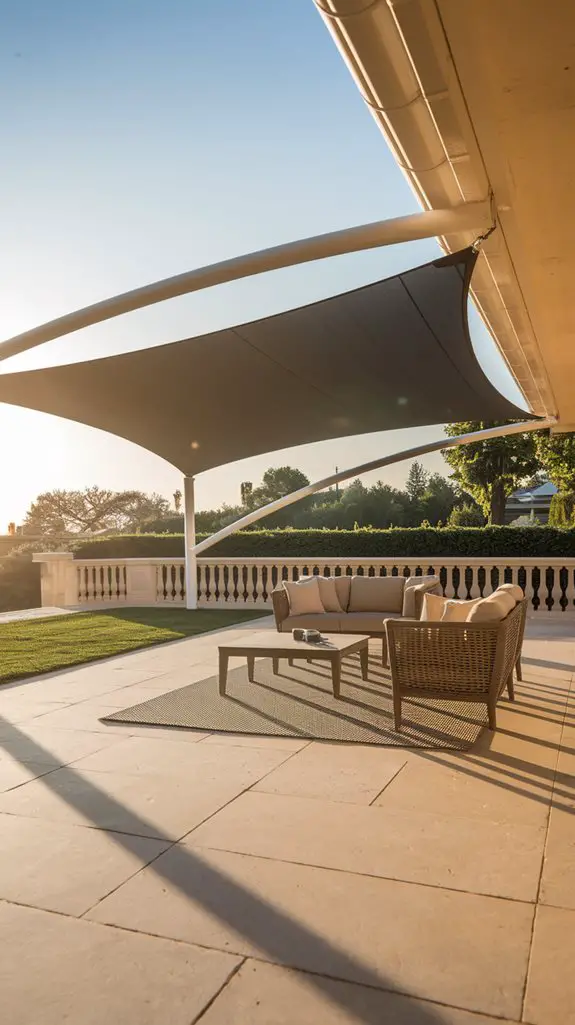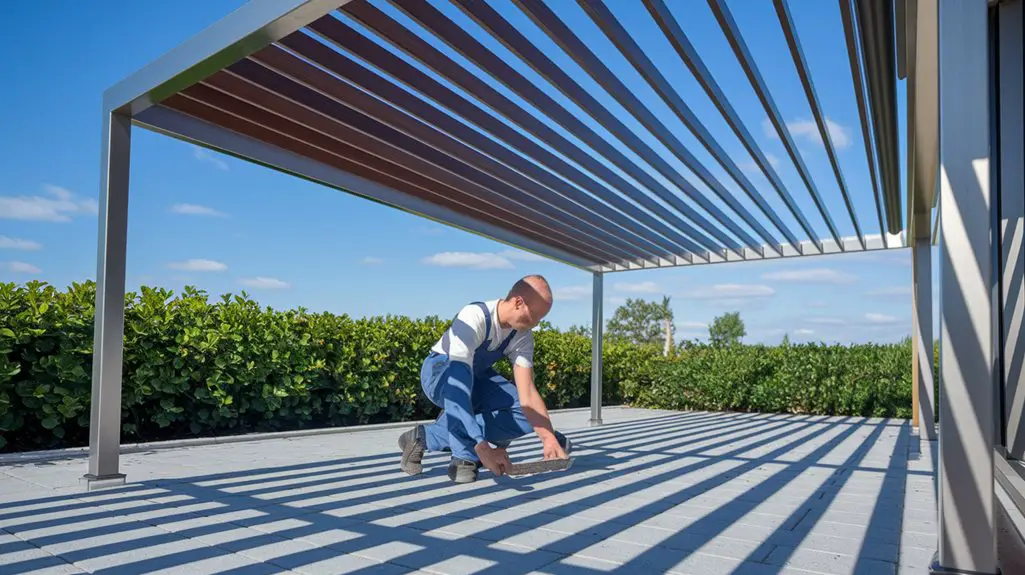You’re about to transform your outdoor living space, but the relentless sun threatens to limit your enjoyment. A properly built shade structure becomes not just an aesthetic addition but a functional necessity for your patio. Beyond temporary solutions like umbrellas, permanent structures offer lasting protection against elements while enhancing your property’s value. The key lies in selecting appropriate materials and designs that withstand years of weather exposure. What options will work best for your specific situation?
Assessing Your Patio: Sun Patterns and Shade Requirements
How effectively you shade your patio depends on understanding the specific sun exposure patterns it experiences throughout the day and across seasons.
Begin by tracking sun movement across your outdoor space for several days, noting where direct sunlight falls and at what times.
Consider seasonal variations—summer sun sits higher in the sky and creates different shadow patterns than winter sun. Measure the angles using a sun path calculator or smartphone app to determine ideal shade placement.
Identify your priority shade periods. Is afternoon protection most critical, or do you need morning coverage?
Map fixed obstacles like buildings or trees that already provide natural shade. Document temperature variations in different patio zones, as dark surfaces can radiate significant heat even in partial shade. Additionally, explore affordable patio shade ideas that can enhance your outdoor comfort without breaking the bank.
Popular Permanent Shade Structure Options for Patios

When creating a permanent shade solution for your outdoor living space, several structural options provide reliable protection from the elements year-round.
Pergolas offer architectural interest with their open-beam design, allowing for partial shade that’s enhanced with climbing vines or fabric canopies.
Solid roof pavilions deliver complete protection from sun and rain, featuring materials like metal, shingles, or polycarbonate panels.
Gazebos provide 360-degree coverage with their distinctive octagonal shape and ornamental design elements.
For modern aesthetics, louvered roof systems offer adjustable aluminum slats that pivot to control sunlight and ventilation.
Custom-built arbors create defined entryways while supporting shade-producing vegetation.
In addition to these options, inspiring gazebo designs can elevate the aesthetic appeal of your outdoor oasis.
Each structure requires different installation complexity, permits, and maintenance considerations, so evaluate durability requirements against your climate conditions before making your selection.
Materials That Withstand the Elements Year After Year

Selecting materials that maintain structural integrity and appearance through years of exposure requires careful consideration of climate factors and maintenance preferences.
For high-wind areas, aluminum and steel provide ideal strength-to-weight ratios while resisting corrosion when properly treated.
Cedar and redwood offer natural beauty and moderate weather resistance, though they’ll require annual sealing.
For superior longevity, composite materials blend wood fibers with polymers to resist rot, insects, and UV radiation without regular maintenance.
Fabric canopies should be constructed from solution-dyed acrylics or HDPE (high-density polyethylene) that resist fading and mildew.
In regions with heavy snow loads, polycarbonate panels deliver exceptional impact resistance while filtering UV rays.
For coastal environments, marine-grade stainless steel fasteners prevent premature structure failure caused by saltwater corrosion that affects standard hardware. Additionally, using eco-friendly materials in your water feature can enhance sustainability in your backyard.
Essential Design Considerations for Structural Integrity
While aesthetic appeal often drives initial design choices, structural integrity remains the foundational element that guarantees your shade structure withstands environmental forces safely.
You’ll need to calculate load-bearing requirements accounting for both dead loads (structure weight) and live loads (wind, snow, rain).
Ensure proper footing depth and concrete strength for your soil type and frost line. Set posts at minimum 3 feet deep in areas with freezing temperatures.
Incorporate diagonal bracing to resist lateral forces, and use appropriate connectors like galvanized joist hangers and hurricane ties.
Don’t overlook rafter sizing and spacing—they’re critical to preventing sagging and failure. For structures wider than 12 feet, consider adding intermediate support posts.
Finally, check local building codes which often mandate specific engineering requirements based on your region’s weather patterns. Additionally, consider incorporating DIY patio shade options to enhance the functionality of your structure while providing comfort on sunny days.
DIY vs. Professional Installation: Making the Right Choice
The decision between DIY installation and professional contractors represents a significant fork in your shade structure journey after you’ve addressed structural integrity concerns.
Your choice should balance cost considerations against technical complexity and safety factors.
DIY installation suits those with carpentry experience and smaller structures using pre-fabricated components.
You’ll save on labor costs but need to invest in specialized tools and allocate sufficient time for proper execution.
Professional contractors bring expertise in building code compliance, proper anchoring techniques, and structural engineering principles.
They’re essential for complex designs, large spans, or installations requiring electrical integration.
While more expensive, professionals provide warranties, handle permits, and guarantee safety standards are met—critical factors for permanent structures that must withstand environmental stresses for years.
In addition, customizable outdoor seating ideas can greatly enhance the overall functionality and aesthetics of your patio space.
Integrating Lighting and Other Features Into Your Shade Structure
A well-designed shade structure transcends mere functionality when you thoughtfully integrate lighting and additional features that enhance both aesthetics and usability.
Consider recessed LED fixtures for ambient illumination or string lights for a more intimate atmosphere. Permanent wiring requires weatherproof components and possibly professional electrical work.
Beyond lighting, incorporate practical elements like ceiling fans to improve air circulation or built-in speakers for entertainment. Automated retractable screens offer protection from insects while maintaining views. For year-round comfort, install infrared heaters or misting systems. Additionally, using backyard lighting can dramatically transform the overall ambiance of your outdoor space.
Mount hardware on support posts or conceal wiring within beams during construction. Use smart home technology to control these features remotely.
When designing your integration plan, guarantee all additions complement your structure’s weight capacity and architectural style while maintaining necessary clearances for safety and functionality.
Maintenance Tips to Extend Your Shade Structure’s Lifespan
Regular maintenance guarantees your shade structure remains both functional and aesthetically pleasing throughout its expected lifespan. Implementing a seasonal inspection and cleaning regimen will prevent minor issues from developing into costly repairs. Additionally, incorporating solar-powered lights can enhance the ambiance of your patio while providing practical illumination.
| Maintenance Task | Recommended Frequency |
|---|---|
| Fabric cleaning | Quarterly |
| Hardware inspection | Bi-annually |
| Rust treatment | Annually |
| Structural assessment | Annually |
For fabric canopies, use mild soap and water, avoiding abrasive cleaners that degrade protective coatings. Tighten all fasteners and inspect for corrosion, especially after stormy seasons. Apply appropriate sealants to wooden components annually to prevent rot and warping. During winter months in harsh climates, consider removing fabric elements or installing protective coverings to prevent snow load damage.
Budgeting for Long-Term Shade Solutions
While evaluating patio shade options, you’ll need to contemplate both immediate costs and long-term investments to make financially sound decisions.
Calculate the total cost of ownership, including installation, maintenance, and replacement cycles.
Permanent structures like pergolas require higher upfront capital ($2,000-$10,000) but typically last 15-20 years with proper maintenance.
Semi-permanent solutions such as retractable awnings ($1,000-$3,500) offer 8-12 years of service with occasional fabric replacement.
Temporary options like umbrellas ($100-$500) require annual replacements.
When budgeting, allocate 10-15% of your initial investment for annual maintenance.
Consider warranty coverage, material durability, and climate factors that affect longevity.
Premium materials often justify their cost through extended lifespans and reduced maintenance expenses. Additionally, investing in luxurious shade options can elevate the aesthetic appeal of your outdoor space while providing practical benefits.
Permits and Regulations: What You Need to Know Before Building
Before starting your patio shade structure project, you’ll need to navigate the often complex world of building permits and local regulations.
Most municipalities require permits for permanent structures, especially those exceeding specific height or square footage thresholds.
Contact your local building department to determine requirements for your zone. You’ll likely need to submit detailed plans showing dimensions, materials, and anchoring methods.
HOA covenants may impose additional restrictions on aesthetics and placement.
Be aware of setback requirements that dictate minimum distances from property lines. Some areas have specific wind load requirements for shade structures to guarantee they withstand local weather conditions. Additionally, consider using eco-friendly materials for your shade structure, as they can enhance sustainability and address environmental concerns.
Failure to obtain proper permits can result in fines, removal orders, and complications when selling your property.
Conclusion
Your patio shade structure stands as both sanctuary and sentinel against nature’s intensity. You’ve weighed materials, designs, and installation methods to create a lasting outdoor retreat. Like a well-constructed ship weathering life’s storms, your shade solution will protect gatherings for years to come. With proper maintenance and thoughtful integration of features, you’ve transformed mere outdoor space into an architectural extension of your home’s protection and comfort.




